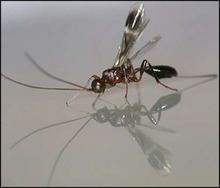Rank Species | Higher classification Spathius | |
 | ||
Similar Spathius, Tetrastichus planipennisi, Oobius agrili, Insect, Hymenopterans | ||
Spathius agrili is a parasitic non-stinging wasp of family Braconidae which is native to North Asia. It is a parasitoid of the emerald ash borer (Agrilus planipennis Fairmaire, family Buprestidae), an invasive species which has destroyed tens of millions of ash trees in its introduced range in North America. As part of the campaign against the emerald ash borer (EAB), American scientists in conjunction with the Chinese Academy of Forestry searched since 2003 for its natural enemies in the wild leading to the discovery of several parasitoid wasps, including Spathius agrili which was discovered in Tianjin, China where it is a prevalent gregarious ectoparasitoid of EAB larvae in stands of Fraxinus velutina, an ash species native to Mexico and southwestern U.S.A., and one ash tree endemic to the region, Fraxinus mandshurica and has been recorded to attack and kill up to 90 percent of EAB larvae.
The life cycle of the wasp was found to be synchronized with that of its preferred host stages - the emergence of adult wasps took place when third and fourth-instar larvae of EAB were available. S. agrili completes three generations per year (Yang et al. 2005). The female wasps can oviposit through the tree bark, paralyzing the larva and laying a clutch of eggs on the integument. When the larvae mature, they spin a cocoon and pupate within the host gallery. Spathuis overwinter as pupae inside cocoons under the bark of ash trees and emerge as adults in the summer. No-choice laboratory assays of larval wood-boring insects from China and North America showed some overlap in the physiological host.
Biological control
Spathius agrili, a gregarious larval ectoparasitoid, Tetrastichus planipennisi, a gregarious larval endoparasitoid, and Oobius agrili, a solitary, parthenogenic egg parasitoid, has been introduced and released into the United States of America as a possible biological control of the EAB. However of the three, Tetrastichus planipennisi has showed best results in affecting EAB and establishing surviving populations.
Research on the viability of as an effective biocontrol agent is ongoing in the US. Laboratory methods have been developed for continuous rearing of this and other species of EAB parasitoid wasps. Extensive studies on the specificity of these parasitoids on native beetles and other insects has been carried out. No-choice laboratory assays of larval wood-boring insects from China and North America showed some overlap in the physiological host range of S. agrili, although successful parasitism was significantly lower in non-hosts than in EAB. S. agrili also did not attack any borers in genera other than Agrilus. S. agrili was only attracted to select species of Fraxinus and to Salix babylonica. Since in nature, if parasitoids are not attracted to the host tree they will be unlikely to encounter and parasitize the non-target larvae, and considering the results from no-choice and olfactometer tests, the lack of S. agrili reared from other Agrilus spp, the wasp has been accepted for controlled releases in specific study sites for further research.
